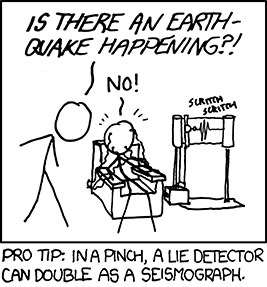711: Seismograph
| Seismograph |
 Title text: The reverse only works if the subject has a nervous twitch. |
Explanation[edit]
A polygraph (popularly referred to as a lie detector) measures and records several physiological indices such as blood pressure, pulse, respiration, and skin conductivity while the subject is asked and answers a series of questions. The belief underpinning the use of the polygraph is that deceptive answers will produce physiological responses that can be differentiated from those associated with non-deceptive answers. Polygraphs are generally considered to be pseudoscientific and are not admissible as evidence. (They've been described as worse than coin toss to determine whether an individual is a trained double agent, for instance. The reasoning is that while the coin toss is [also] randomly incorrect about half the time, at least you can't train to beat the coin toss every time). However, they can be an effective prop to convince suspects that interrogators will know if they lie.
A seismograph is a machine which measures and records the ground's motion during e.g. an earthquake. Older seismographs held a pen against a slowly turning roll of paper, and ground motions were amplified and recorded as spikes in the pen line.
The lie detector works by measuring physiological signals which could presumably be visualized by drawing a line on paper like a seismograph. It is assumed that when someone is lying, their physiological signatures will be sharper and more stressed. In the comic, the character on the right is hooked up to the lie detector, and apparently must answer "No" to the question of the earthquake. As long as there is no earthquake, then the subject will be telling the truth, and the polygraph signal will be more stable. But if there is really an earthquake happening, then the subject is lying, and so the polygraph will show sharper signals. This mimics the effect of an actual seismograph. It is not clear why the two characters seem to be upset with each other. It is perhaps because the scene mimics a polygraph test where the subject is trying to hide something. Or, more likely, they are simply panicked.
The title text considers the idea of using a seismograph as a lie detector. If the subject has a nervous twitch, presumably they will twitch in some way when they are telling a lie. This would require them to twitch hard enough to vibrate the ground around them, a vibration that can be picked up on a nearby seismograph.
Transcript[edit]
- [Cueball is standing over another man, who is strapped into a chair with wires attached to his head and arms. The wires lead to a large lie detector on a stand next to him, which has jagged lines drawn across it.]
- Cueball: IS THERE AN EARTHQUAKE HAPPENING?!
- Sitting man: No!
- Lie detector: scritch scritch
- [Caption below the panel:]
- Pro tip: In a pinch, a lie detector can double as a seismograph.
Discussion
The explanation says "As long as there is no earthquake, then the subject will be telling the truth, and the polygraph signal will be more stable. But if there is really an earthquake happening, then the subject is lying, and so the polygraph will show sharper signals. This mimics the effect of an actual seismograph."
That is not correct. Lie Detectors only detect whether a person believes or disbelieves something. They do not detect whether that belief is true or false. If the person believed an earthquake was happening then even if no earthquake was occurring if the person said "no" then theoretically the detector would respond with greater movement. However, there are ways to "fool" a lie detector. --162.158.123.157 03:33, 18 December 2019 (UTC)
- Incorrect as well; "Lie detectors" measure galvanic skin response, that's it. Everything else is just made up by "lie detector" machine salespersons.
